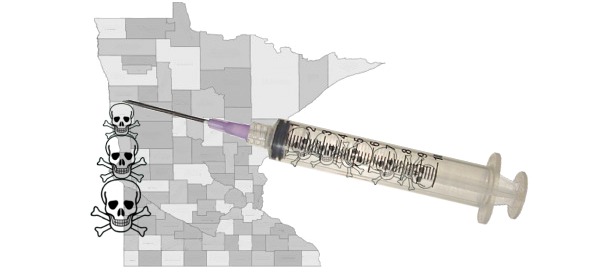Conventional Med
Fecal Transplant: Allopathic Cure for Drug Resistant Bugs Coopted from Natural Med & Adulterated

With the title of this article, what sort of picture were you expecting? (Photo by Trey Ratcliff, http://stuckincustoms.com)
Conventional medicine has found a treatment that truly does cure bacterial infections. It doesn’t use drugs. It uses the feces of a healthy person and implants them into the infected person.
The method itself is rather invasive, but the concept is right out of alternative medicine. Rather than trying to poison the problem into submission with pharmaceuticals, they’re correcting an imbalance.
Will they take on the bigger lesson of this finding, that health is not found in chemicals, but in helping the body heal itself?
Fecal Transplant
A study presented at the American College of Gastroenterology (ACG) 2011 Annual Scientific Meeting and Postgraduate Course reported that Clostridium difficile infections were fully cured through fecal transplants, which are also called fecal bacteriotherapy, fecal transfusions, stool transplants, and human probiotic infusion.
Fecal Transplant Process
The procedure for doing a fecal transplant involves 5 to 10 days of enemas to clear the patient’s system of as much of the existing intestinal contents as possible. Stool is harvested from a healthy donor, preferably a relative, who has been tested to assure freedom from disease bacteria and parasites.
The healthy stool is administered to the patient in one of two ways, and preferably by both methods. One is by an effusion of the healthy stool administered by enemas, and the other is to administer it through a nasogastric tube that runs through the stomach and into the small intestine.
Results
C. difficile infections are particularly difficult to cure. Worse, they tend to recur in about half the patients who seemed to have been cured. The study presented at ACG examined 77 subjects, all of whom had been through at least 2 rounds of antibiotics, and an average 5 rounds, without success. Lead researcher, Mark Mellow, MD, of Integris Baptist Medical Center in Oklahoma City, reported that 91% of the patients were cured. A cure was defined as no relapse within three months of treatment.
A few patients received continuing antibiotic treatment for other conditions. They didn’t do as well as those who took no antibiotics.
Mellow reported:
Patients with recurrent C. difficile infection had a totally different population in their stool than normal people, characterized by a marked decrease in the diversity of species present. Therefore, it would make sense that if you performed a massive bacterial replacement, that might very well reverse that condition and allow for a cure in people who were otherwise not curable.
Six patients who were not cured by the initial fecal transplant procedure were moved into the cured camp after being treated with the antibiotic, Vancomycin, coupled with either probiotics or another fecal transplant.
Mellow said that the patients were not troubled at the idea of a fecal transplant:
They’re desperate people seeking desperate measures so they didn’t have much of a problem with it. We have to stop thinking of stool as a smelly inert substance. It’s an incredibly biologically active substance.
The results weren’t quite as good as initially described. Patients were followed up for 17 months. During that time, two patients with preexisting ailments, one patient with arthritis and another with sinus allergies, improved after their fecal transplants. However, four patients developed new conditions: peripheral neuropathy, Sjogren’s syndrome, rheumatoid arthritis, and idiopathic thrombocytopenia. One patient, who had been in hospice care, died.
Lesson Learned?
Fecal transplants are not simple procedures, nor are they entirely without risk. It’s tempting to criticize them for the new problems experienced by improved patients. However, the average subject was 65 years old, and most had experienced long term debilitating illness before their treatment. To imply a cause-effect relationship between new illnesses and the treatment would be to ignore the patients’ underlying ill-health.
Mellow anticipates a bright future for fetal transplants for C. difficile treatment and likely for other conditions. However, he speaks in terms of intractable cases only. And therein lies the quandary.
How close to nature are fecal transplants?
Fecal transplants, though considerably closer to natural than antibiotics, still share more in common with conventional medicine’s invasive measures. The patients are subjected to days of enemas to eliminate their natural biota. They are then subjected either to enemas or nasogastric tubes from mouth through esophagus and stomach to the intestines to introduce presumed healthy fecal material from other people.
Though certainly an improvement over antibiotic pharmaceuticals, this is not a matter of allowing the body to heal itself. Patients are still being treated to the same old invasive methods, albeit without slicing them open or giving them poisons…well, not entirely without drugs, as they are used to administer nasogastric tubes.
They seem rather mystified that the biota of people who’ve been administered potent antibiotics are deranged. In the quotation above, Mellow noted, “Patients with recurrent C. difficile infection had a totally different population in their stool than normal people, characterized by a marked decrease in the diversity of species present.” He states it as if it were a mystery, but it’s crystal clear why the gut biota of people with C. difficile are abnormal. Why don’t they notice that C. difficile is an iatrogenic disorder—that it’s caused by the treatments delivered or contact with their treatment centers?
Does it never occur to them to avoid antibiotics, which they must know destroy intestinal fauna, and instead try to help the body reconstitute the damaged gut biosystem with probiotics?
But that wouldn’t be thought of as medicine, would it? Allopaths seem to gravitate towards heroic treatments, methods that are full of risks and can be expected to cause long term harm—such as damage to the immune system from antibiotics, and of course, C. difficile infections. It seems to be quite difficult for them to accept that real healing comes from the body itself, not from drugs and extreme treatments.
Effects of Big Pharma Connections
That isn’t surprising, though, when you see the connections between Big Pharma, conventional medicine, and the agencies that purportedly police the industry. They all profit from the old heroic methods. Therefore, they promote what benefits their wallets.
What of the patients? Except when it’s convenient, they’re ignored. The patient who says, “Hey Doc! I had really bad diarrhea, but cleared it up by taking probiotics,” is likely to be pooh-poohed, the incident ascribed to either the placebo effect or an anecdote, which the medical system has defined as meaningless—except, of course, when a case is written up in a medical journal. When that happens, such cases are cited and re-cited as evidence.
Of course, probiotics, especially when the patient chooses that method without the doctor’s preapproval, must be scoffed. They haven’t been subjected to the pseudo-science of evidence-based medicine. More importantly, neither the doctor nor the pharmaceutical manufacturers can profit from them…yet.
Therefore, truly natural methods of healing, like probiotics, must be suppressed. But in these interesting times, that’s changing. The people’s direct access to virtually all natural methods of healing are being brutally suppressed. Raw milk is a major target now, with military-style SWAT operations on producers and sellers who have done neither wrong nor harm. Vaccines are being mandated to more and more children. Vitamins, supplements, and herbs are being taken out of the people’s hands.
All of these things are being handed over to Big Pharma and Big Medicine. Once that task has been completed, the people will be allowed access, with a few exceptions, like raw milk. But access will come at extremely high cost. It will require visiting and paying a doctor, who will have the power to grant or deny access. Big Pharma will produce the products that had once been freely available to the people as a natural birth right.
And Big Pharma will adulterate the natural products, homogenizing, pasteurizing, hydrogenating, radiating, and genetically engineering them—all in the name of safety, of course, but actually for the benefit of profits.
Fecal Transplant, Anyone?
We’re approaching an age when fecal transplants will be promoted as the latest and greatest health treatment ever found. They’ll be available only through doctors, with associated risks. And more and more people will need the treatment, because genuine health treatments—especially prevention—will be inaccessible, except in dribs and drabs at exhorbitant costs.
References:
- Fecal Microbiota Transplants Effective Treatment for C. Difficile, Inflammatory Bowel Disease, Research Finds
- ACG: Refractory Bacteria Respond to Fecal Transplant
- Stool Transplants Stop 90% of C difficile
Tagged conventional medicine, fecal transplant, pharmaceutical drugs, pharmaceuticals
Related Posts
-
Anonymous
-
Louis Jans
-
Anonymous
-
http://www.facebook.com/profile.php?id=616227597 Liesl Diesel
-
-
Oklahoma doctor INTEGRIS















